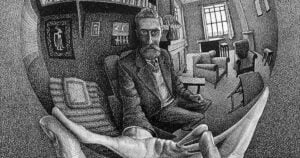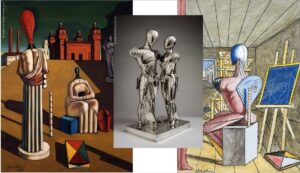Negli anni in cui massima importanza e prestigio erano dati al mestiere delle armi, un condottiero, un leader carismatico come Federico da Montefeltro non poteva sentirsi escluso dal virile rito della guerra. Le stanze di un palazzo erano troppo strette per un uomo che, pur circondandosi di letterati e artisti – tanto è vero che riunirà attorno alla sua figura i migliori intellettuali dell’epoca -, faceva della presenza in campo durante la battaglia un punto d’onore.
Anche per questo motivo il torneo del 1450, organizzato nella “sua” Urbino e a cui partecipò, gli fu certo molto indigesto. Nella foga della contesa, un avversario penetrò con la punta della lancia la celata dell’elmo di Federico, che perse in questo modo l’uso dell’occhio destro. Dopo aver lottato con la morte per mesi, ecco la stoica decisione, indice del coraggio e dell’incapacità a rassegnarsi: egli si fece tagliare la parte superiore del naso – già ferita, in parte, dallo stesso colpo di lancia -, in modo da poter vedere bene anche a destra e, quindi, combattere come se nulla fosse accaduto. Il duca morirà nel 1482, trentadue anni dopo il torneo, e dopo aver superato indenne numerose battaglie.
Potrebbe essere vera la frase leggendaria che molti gli attribuirono poco dopo l’incidente: “Pazienza, ci vedrò meglio con un occhio che con cento”. Il taglio del naso è riscontrabile, insieme ad altri segni quali le cicatrici sulla pelle, conseguenze di una vita militare intensa, nel celebre Ritratto di Federico da Montefeltro di Piero della Francesca. Nell’opera, la posizione del volto deriva dalla tradizione medaglistica ma probabilmente anche dall’imperativo del duca, che volle essere effigiato dal lato sinistro in modo da nascondere, in parte, la menomazione all’occhio.
PUOI RICEVERE GRATUITAMENTE, OGNI GIORNO, I NOSTRI SAGGI E I NOSTRI ARTICOLI D’ARTE SULLA TUA HOME DI FACEBOOK. BASTA CLICCARE “MI PIACE” ALL’INIZIO DI QUESTA PAGINA. STILE ARTE E’ UN QUOTIDIANO , OGGI ON LINE, FONDATO NEL 1995
This article has been traslated by http://translate.google.it/
During the years when the utmost importance and prestige were given to the profession of arms, a leader, a charismatic leader such as Federico da Montefeltro could not feel excluded from the manly ritual of war. The rooms of a building were too narrow for a man who, while surrounding himself with writers and artists – so much so that gather around him the best intellectuals of the time – was the presence on the field during the battle a point of honor .
This is also why the tournament in 1450, organized in “his” Urbino and which he participated, he was certainly very indigestible. In the heat of the contest, an opponent with the tip of the spear pierced his visor of the helmet of Frederick, who lost in this way the use of the right eye. After struggling with death for months, here is the Stoic decision, index of courage and inability to resign: he had cut off the top of the nose – already injured, in part, by the same spear – in order to be able to see well to the right and then fight as if nothing has happened. The duke died in 1482, thirty years after the tournament, and after many battles unscathed.
It may be true that many of the legendary phrase attributed shortly after the incident: “Patience, we’ll see better with one eye than with a hundred.” The cut of the nose can be found, along with other signs such as scars on the skin, the consequences of a military life intense, in the famous portrait of Federico da Montefeltro by Piero della Francesca. In the work, the position of the face comes from the tradition medals but probably also by the imperative of the duke, who wished to be depicted on the left side to hide, in part, the impairment to the eye.

Federico da Montefeltro, l’uomo che inventò la rinoplastica/ Federico da Montefeltro, the man who invented the rhinoplasty
More from NewsMore posts in News »

